
Glenmore Homestead is a heritage-listed homestead at Belmont Road, Parkhurst, Rockhampton Region, Queensland, Australia. It was built from c. 1858 to c. 1920. The homestead and associated buildings once belonged to pastoral run on the Fitzroy River, seven kilometres northwest of Rockhampton, Queensland. Originally much larger at 127 square miles the current size of the property is 20 acres (8.1 ha). It was added to the Queensland Heritage Register on 21 October 1992.

Canning Downs was the first residential establishment built by a white person on the Darling Downs in Queensland, Australia. It is located a short drive from the town of Warwick and originally extended south east to Killarney and the McPherson Range. The area was first named after the British statesman George Canning by Allan Cunningham.

Mayes Cottage is a nineteenth century, heritage-listed house museum located at 20 Mawarra Street, Kingston, City of Logan, Queensland, Australia. Originally called Pleasant Place, it was built in 1877 by the Mayes Family. It was added to the Queensland Heritage Register on 21 October 1992.
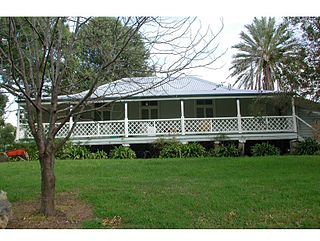
Jondaryan Homestead is a heritage-listed homestead at Evanslea Road, Jondaryan, Toowoomba Region, Queensland, Australia. It was the base of the former Jondaryan pastoral station, which was originally taken up in 1840, and at one time was the largest freehold station in Queensland. The site contains the current house, which was built after the original was destroyed by fire in 1937, the original kitchen dating from 1844, and a kitchen, butcher's shop, shearer's quarters, stables, dairy, toilet block and store, many dating from the 1860s. It also contains the remains of horse stalls, a slaughterhouse, hide store, and Chinese gardener's glasshouse. It was added to the Queensland Heritage Register on 21 October 1992.
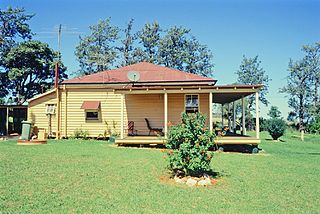
O'Shea's Drayton Cottage is a heritage-listed cottage at 56 Gwynne Street, Drayton, Toowoomba Region, Queensland, Australia. It was built from c. 1874 to 1910s circa. It was added to the Queensland Heritage Register on 27 April 2001.
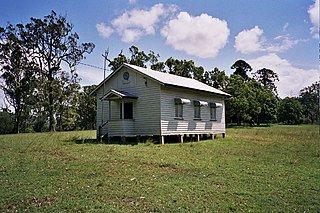
Wonglepong QCWA Hall is a heritage-listed community hall at 2779 Beaudesert-Nerang Road, Wonglepong, Scenic Rim Region, Queensland, Australia. It was built in 1935 by EJ Franklin. It was added to the Queensland Heritage Register on 11 November 2005.

Kingaroy Peanut Silos is a heritage-listed silos at 117-131 Haly Street, Kingaroy, South Burnett Region, Queensland, Australia. It was designed by Thomas Robinson & Son and Macdonald Wagner Consulting Engineers and built in 1938 by Kell & Rigby. It was added to the Queensland Heritage Register on 8 October 2010.

Tallegalla State School is a heritage-listed former state school at Rosewood-Minden Road, Tallegalla, City of Ipswich, Queensland, Australia. It was built from 1879 to 1955. It was added to the Queensland Heritage Register on 2 February 1998.

Rockton is a heritage-listed villa at Rockton Street, Newtown, City of Ipswich, Queensland, Australia. It was built from 1855 onwards. It was added to the Queensland Heritage Register on 21 October 1992.

Toronto is a heritage-listed detached house at 30 Quarry Street, Ipswich, City of Ipswich, Queensland, Australia. It was built from 1863 onwards. It is also known as Devonshire Cottage. It was added to the Queensland Heritage Register on 21 October 1992.
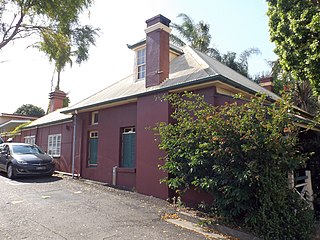
Ginn Cottage is a heritage-listed detached house at 1 Ginn Street, Ipswich, City of Ipswich, Queensland, Australia. It was built from c. 1859 to c. 1910. It was added to the Queensland Heritage Register on 21 October 1992.

The Selector's Hut is a heritage-listed hut at 20 Upper Camp Mountain Road, Camp Mountain, Moreton Bay Region, Queensland, Australia. It is also known as Marks' Hut. It was built c. 1870 by George Atthow. It was added to the Queensland Heritage Register on 3 December 2007.

Conondale Timbers sawmill is a heritage-listed sawmill at Aherns Road, Conondale, Sunshine Coast Region, Queensland, Australia. It was built in the 1930s by M R Hornibrook Ltd. It is also known as Conondale Timbers mill workers cottages. It was added to the Queensland Heritage Register on 27 November 2008.

Glengarry Homestead is a heritage-listed homestead at Gladstone-Monto Road, Boynedale, Gladstone Region, Queensland, Australia. It was built from c. 1894 to c. 1920. It was added to the Queensland Heritage Register on 21 October 1992.

Strathmore Homestead is a heritage-listed homestead at Strathmore Station on Strathmore Road, Springlands, Whitsunday Region, Queensland, Australia. It was built from the 1860s onward. It is also known as Strathmore Station. It was added to the Queensland Heritage Register on 13 November 2008.
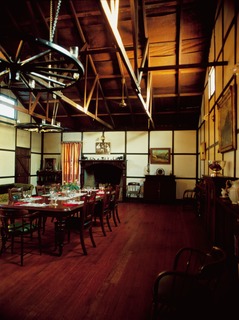
Gunnawarra Homestead is a heritage-listed homestead at Gunnawarra Road, Gunnawarra, Tablelands Region, Queensland, Australia. It was built from 1878 to 1908. It was added to the Queensland Heritage Register on 21 October 1992.

St Michael and All Angels Church is a heritage-listed Anglican church at 2-6 Alford Street, Kingaroy, South Burnett Region, Queensland, Australia. It was designed by Colin Deighton and built in 1911. It was added to the Queensland Heritage Register on 17 September 2010.

Burrandowan Station Homestead is a heritage-listed homestead at Kingaroy Road, Durong, South Burnett Region, Queensland, Australia. It was built from 1848 to c. 1927. It was added to the Queensland Heritage Register on 21 October 1992.

Kilbirnie Homestead is a heritage-listed homestead at Argoon-Kilburnie Road, Jambin, Shire of Banana, Queensland, Australia. It was built in 1884. It was added to the Queensland Heritage Register on 21 October 1992.
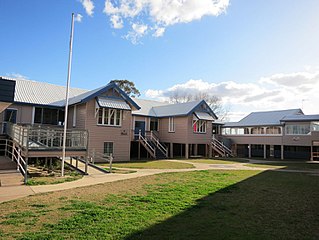
Murgon State School is a heritage-listed state school, pre-school and teacher's residence at 91 Gore Street, Murgon, South Burnett Region, Queensland, Australia. It was designed by Department of Public Works (Queensland) and built from 1914 to 1940. It was also known as Murgon Provisional School and Murgon Rural School. It was added to the Queensland Heritage Register on 9 October 2015.































